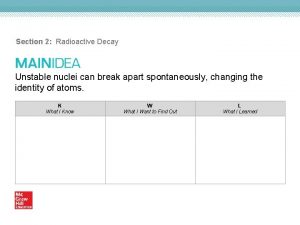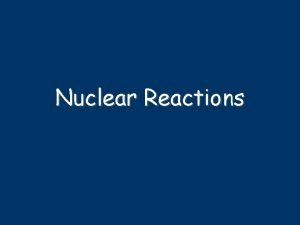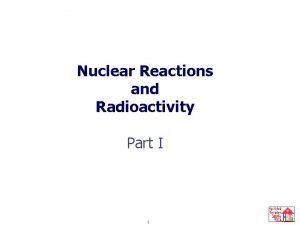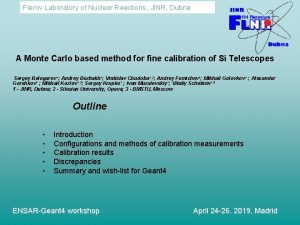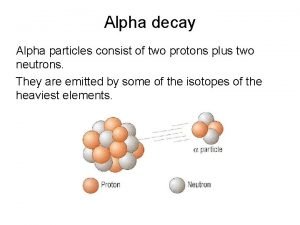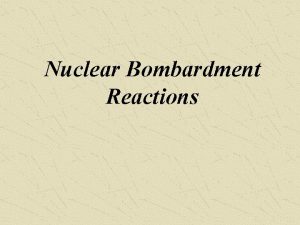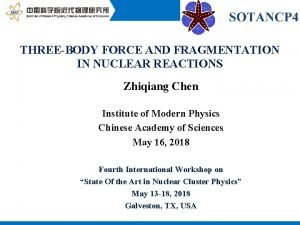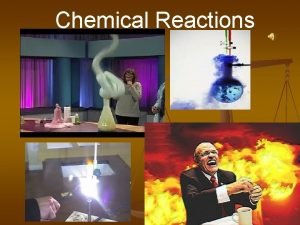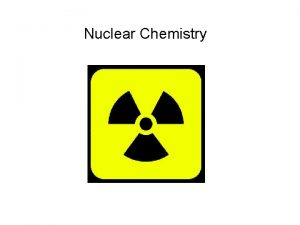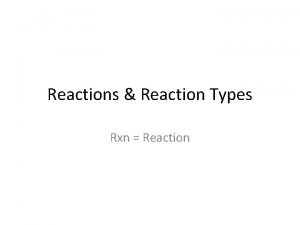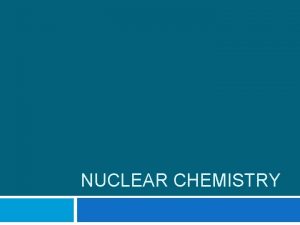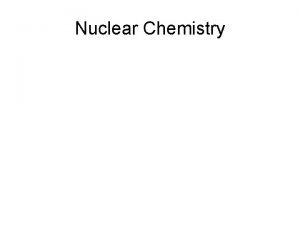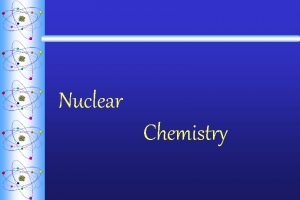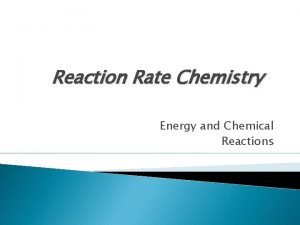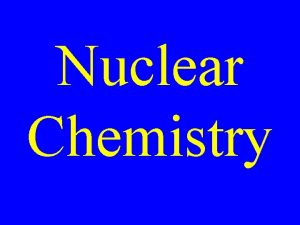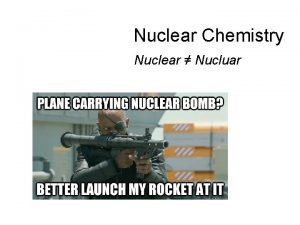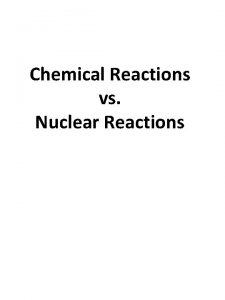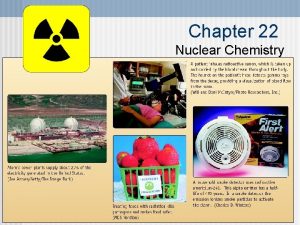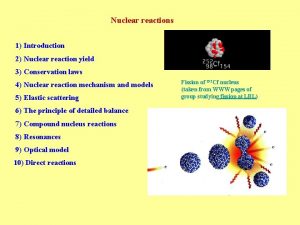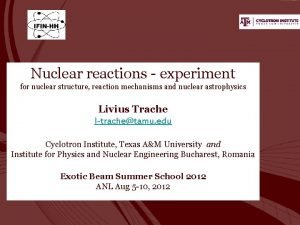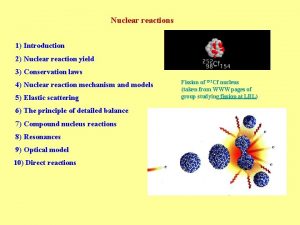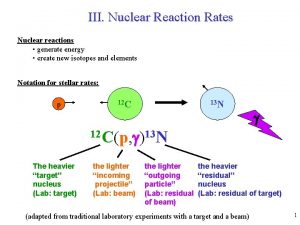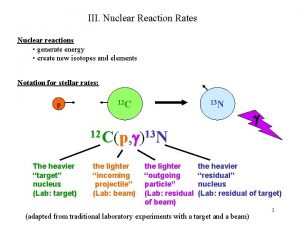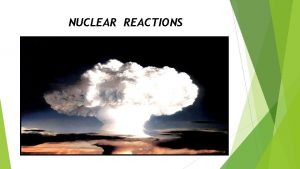Nuclear Chemistry Nuclear Reaction n Nuclear Reactions a




















- Slides: 20

Nuclear Chemistry

Nuclear Reaction n Nuclear Reactions: a nucleus loses or gains protons and neutrons. n Nuclear reactions are independent of other energy influences. n Why do some nuclei undergo radioactive decay? *They are too big and unstable (too many protons)! *Nuclear reactions happen to make atoms more stable.

Nuclear Reactions n During nuclear reactions The total mass of the reactants MUST = the total mass of the products. n The total atomic #s of the reactants MUST = the total atomic #s of the products. n n Reminder: mass # 9 4 atomic # Be

Alpha (α) Decay n 42 Alpha particle: He n Biggest mass n Lowest energy radiation. n Can be stopped by a sheet of paper or skin. n Has a charge of +2.

Alpha Decay Problems Example: 238 U 92 n Practice: n 1. 234 Th 90 2. 218 84 Po 3. Write an equation that represents the alpha decay of Rn-222.

Beta (β) Decay 0 e 0β Beta particle: or -1 -1 n Can be stopped by aluminum foil or a piece of wood. n Has a charge of -1.

Beta Decay Examples 238 92 n Example: n Practice: 218 Po 1. 84 U 2. Write the equation for the beta decay of Pb-214.

Gamma Decay n Gamma (γ) Decay: A gamma ray (high energy electromagnetic wave) is released from the nucleus. n Highest energy radiation. n Lowest mass n Can be stopped by lead or concrete. n Almost always occurs with alpha or beta decay.

Summary of Particles Particle Symbol Mass Alpha 4 2 He Ability to go through things 4 weak Beta 0 e -1 0 medium Gamma γ 0 strong


Nuclear Fission n Nuclear Fission: A large nucleus is split into two or more nuclei. n Nuclear chain reaction: continuous series of fission reactions n Lots of energy released! n Applications: * If controlled - used in power plants * If uncontrolled – used for atomic bombs

Nuclear Fission Applications

Nuclear Power Plants – Use controlled fission reactions.

Nuclear Fusion n Nuclear Fusion: Two or more small nuclei combine to form a larger nucleus. Occurs on the sun and other stars (not on Earth!). n Produces enormous amounts of energy n Requires extremely high temperatures to start n

Fission vs. Fusion n How to remember the difference: FISSION = SPLIT n FUSION = PUT TOGETHER n

Half-Life n Radioactive Half-Life (t 1/2): the amount of time it takes for half of the atoms to undergo decay. n Use: dating fossils (carbon-14 dating)

Half-Life Example Problems 1) The half-life of an element is 10 years. You start with a sample of 20 grams of that element. a) How much will you have after 10 years? b) How much will you have after 20 years? c) What fraction of the original amount will be left after 4 half-life periods? d) After 7 half-life periods?

Half-Life Example Problems 2) A radioactive substance with a half-life of 8 years is allowed to decay. If the sample started out with 80 grams and ended with 10 grams, how many years have passed? 3) You started with a sample of 70 grams of a radioactive material. After 30 years, you only had 8. 75 grams left. What is the half-life of this substance? 4) You have 60 grams of Potassium-40 (half-life = 1. 25 years). If this sample has been decaying for 5 years, how much did you start with?

Uses of Nuclear Radiation n n Dating Fossils Smoke Detectors n Contain Americium which gives off alpha particles – producing a current. Smoke interrupts the current. Detection of Diseases n Radioactive tracers Radiation Therapy for Cancer

How much radiation have you been exposed to? n Have you ever…. n n n Traveled in an airplane? Gone through luggage inspection at the airport? Eaten a banana? Smoked? Watched TV? Sat in front of a computer screen? Been near a smoke detector? Had an x-ray? Lived within 50 miles of a nuclear power plant? Used a cell phone? Most organisms are adapted to survive low levels of background radiation.
 Unit 5 chemical reactions answers
Unit 5 chemical reactions answers Lesson 15 nuclear quest nuclear reactions
Lesson 15 nuclear quest nuclear reactions Neutron emission
Neutron emission Section 2 classifying chemical reactions worksheet answers
Section 2 classifying chemical reactions worksheet answers Redox examples
Redox examples Section 2 reinforcement classifying chemical reactions
Section 2 reinforcement classifying chemical reactions Chemical reactions section 3 reactions in aqueous solutions
Chemical reactions section 3 reactions in aqueous solutions Nuclear decays and reactions section 2
Nuclear decays and reactions section 2 Geiger counter
Geiger counter Natural transmutation equation
Natural transmutation equation Balancing nuclear reactions
Balancing nuclear reactions Activity of radioactive sample
Activity of radioactive sample Flerov laboratory of nuclear reactions
Flerov laboratory of nuclear reactions U 238 alpha decay
U 238 alpha decay Two types of nuclear reactions
Two types of nuclear reactions Nuclear bombardment equation
Nuclear bombardment equation Nuclear reactions are at
Nuclear reactions are at Key terms radioactivity and nuclear reactions
Key terms radioactivity and nuclear reactions Types of reactions chemistry
Types of reactions chemistry 5 types of reactions chemistry
5 types of reactions chemistry Type of reactions chemistry
Type of reactions chemistry







